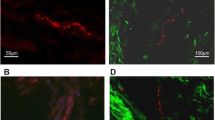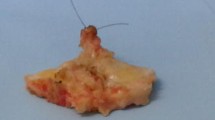Abstract
Introduction
Although the posterior cruciate ligament (PCL) is considered to contain not only proprioceptive but also nociceptive sensory fibers, there is a lack of information about nociceptive sensory innervation of the PCL. We hypothesized that the PCL has constant nociceptive sensory innervation, suggesting the possible source of osteoarthritic (OA) knee pain.
Materials and methods
Innervation of the PCL was examined by immunohistochemistry with particular reference to nociceptive nerve fibers in OA knees. Sensory nerve fibers were semi-quantitatively counted in the PCL of OA knees, comparing with non-OA knees. Protein gene product 9.5 (PGP9.5) as a general neuronal marker and calcitonin gene related peptide (CGRP) as a marker for nociceptive neuron were used.
Results
The PCLs had constant CGRP-immunoreactive (IR) nerve fibers in both OA and non-OA knees. The difference of the CGRP-IR nerve density between groups did not reach a statistical significance (p = 0.062). For PGP9.5-IR nerve fibers, however, the PCLs in OA knees were statistically less innervated than non-OA knees (p = 0.0009).
Conclusions
Our results showed that, in spite of a significant decrease in total innervation in OA knees, the PCLs have constant nociceptive sensory innervation. Although the relationship between the decrease in total innervations in the PCL and OA pathophysiology is still unclear, the PCL is the possible source of OA knee pain. Our results should be taken into account when examining the pain source of the OA knees and handling the PCL during total knee arthroplasty.


Similar content being viewed by others
References
Katonis PG, Assimakopoulos AP, Agapitos MV, Exarchou EI (1991) Mechanoreceptors in the posterior cruciate ligament. histologic study on cadaver knees. Acta Orthop Scand 62:276–278
Franchi A, Zaccherotti G, Aglietti P (1995) Neural system of the human posterior cruciate ligament in osteoarthritis. J Arthroplast 10:679–682
Biedert RM, Stauffer E, Friederich NF (1992) Occurrence of free nerve endings in the soft tissue of the knee joint. a histologic investigation. Am J Sports Med 20:430–433
Nelissen RG, Hogendoorn PC (2001) Retain or sacrifice the posterior cruciate ligament in total knee arthroplasty? a histopathological study of the cruciate ligament in osteoarthritic and rheumatoid disease. J Clin Pathol 54:381–384
Del Valle ME, Harwin SF, Maestro A, Murcia A, Vega JA (1998) Immunohistochemical analysis of mechanoreceptors in the human posterior cruciate ligament: a demonstration of its proprioceptive role and clinical relevance. J Arthroplast 13:916–922
Schultz RA, Miller DC, Kerr CS, Micheli L (1984) Mechanoreceptors in human cruciate ligaments. a histological study. J Bone Jt Surg Am 66:1072–1076
Kaplan FS, Nixon JE, Reitz M, Rindfleish L, Tucker J (1985) Age-related changes in proprioception and sensation of joint position. Acta Orthop Scand 56:72–74
Barrett DS, Cobb AG, Bentley G (1991) Joint proprioception in normal, osteoarthritic and replaced knees. J Bone Jt Surg Br 73:53–56
Pai YC, Rymer WZ, Chang RW, Sharma L (1997) Effect of age and osteoarthritis on knee proprioception. Arthritis Rheum 40:2260–2265
Skinner HB, Barrack RL, Cook SD (1984) Age-related decline in proprioception. Clin Orthop Relat Res 184:208–211
Barrack RL, Skinner HB, Buckley SL (1989) Proprioception in the anterior cruciate deficient knee. Am J Sports Med 17:1–6
Aydog ST, Korkusuz P, Doral MN, Tetik O, Demirel HA (2006) Decrease in the numbers of mechanoreceptors in rabbit ACL: the effects of ageing. Knee Surg Sports Traumatol Arthrosc 14:325–329
Morisawa Y (1998) Morphological study of mechanoreceptors on the coracoacromial ligament. J Orthop Sci 3:102–110
Salo PT, Tatton WG (1993) Age-related loss of knee joint afferents in mice. J Neurosci Res 35:664–677
Salo PT, Seeratten RA, Erwin WM, Bray RC (2002) Evidence for a neuropathic contribution to the development of spontaneous knee osteoarthrosis in a mouse model. Acta Orthop Scand 73:77–84
Ferreira-Gomes J, Adaes S, Sarkander J, Castro-Lopes JM (2010) Phenotypic alterations of neurons that innervate osteoarthritic joints in rats. Arthritis Rheum 62:3677–3685
Schofield JN, Day IN, Thompson RJ, Edwards YH (1995) PGP 9.5, A ubiquitin C-terminal hydrolase: pattern of mRNA and protein expression during neuronal development in the mouse. Brain Res Dev Brain Res 85:229–238
Ackermann PW, Li J, Finn A, Ahmed M, Kreicbergs A (2001) Autonomic innervations of tendons, ligaments and joint capsules. a morphologic and quantitative study in the rat. J Orthop Res 19:372–378
Grorud KW, Jensen KT, Provenzano PP, Vanderby R (2007) Adjuvant neuropeptides can improve neuropathic ligament healing in a rat model. J Orthop Res 25:703–712
Halstead J, Bergin D, Keenan AM, Madden J, McGonagle D (2010) Ligament and bone pathologic abnormalities more frequent in neuropathic joint disease in comparison with degenerative arthritis of the foot and ankle. Arthritis Rheum 62:2353–2358
Jacobs WC, Clement DJ, Wymenga AB (2005) Retention versus sacrifice of the posterior cruciate ligament in total knee replacement for treatment of osteoarthritis and rheumatoid arthritis. Cochrane Database Syst Rev 19:CD004803
Ishida-Yamamoto A, Tohyama M (1989) Calcitonin gene-related peptide in the nervous tissue. Prog Neurobiol 33:335–386
Ikeuchi M, Kolker S, Sluka KA (2009) Acid-sensing ion channel 3 expression in mouse knee joint afferents and effects of carrageenan-induced arthritis. J Pain 10:336–342
Author information
Authors and Affiliations
Corresponding author
Additional information
M. Ikeuchi and Q. Wang contributed equally to this work.
Rights and permissions
About this article
Cite this article
Ikeuchi, M., Wang, Q., Izumi, M. et al. Nociceptive sensory innervation of the posterior cruciate ligament in osteoarthritic knees. Arch Orthop Trauma Surg 132, 891–895 (2012). https://doi.org/10.1007/s00402-012-1478-7
Received:
Published:
Issue Date:
DOI: https://doi.org/10.1007/s00402-012-1478-7




